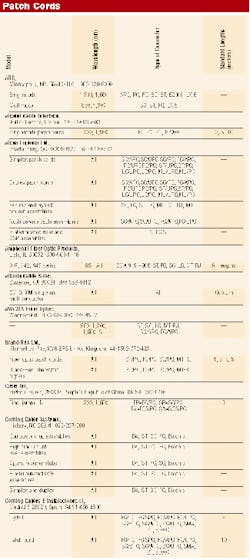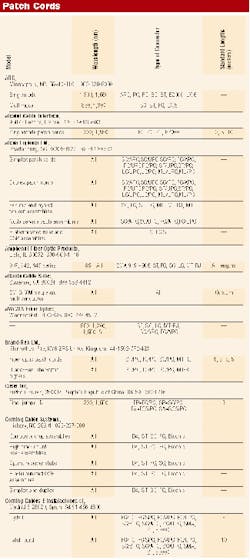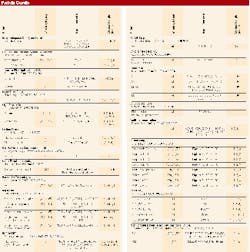Often overlooked, patch cords provide important function
BY MEGHAN FULLER
They are not often in the spotlight. Small, inexpensive, and relatively abundant, patch cords are one of the most frequently overlooked elements in a network-but also one of the most critical. A fiber-optic cable connectorized on both ends, the patch cord is used to finish the link between terminated fiber runs and electronic equipment. Its function is both elementary and essential. In today's networks where a single OC-192 link could generate up to a million dollars in revenue per year, all network elements-patch cords included-must be robust, reliable, and provide optimum performance. Unfortunately, patch cords are not usually forced to live up to the same standards as other equipment in the network, which has led to system failures and lost revenue.
Simply put, a patch cord is a short length of fiber-optic cable used to connect one device to another, much like an extension cord. Explains John Wages, associate product manager at the Siemon Co. (Watertown, CT), "If you think back to the old telephone operators of the early 1900s, they would connect one caller to another caller [using a] wire [similar to a patch cord]. They would take one signal and direct it to a certain path, and that is what a patch cord does." At each end of the patch cord is a connector, typically an SC or FC connector, as the older models, the ST and D4, have dropped in popularity.
Most end users employ some kind of patching. The alternative, hardwiring individual paths, is acceptable but does not provide nearly the same level of flexibility, modularity, or convenience. Asserts Wages, "If you have to move from one office to another, [the patch cord] allows a network manager to redirect your computer, phone, and fax very easily. If it's all hardwired, [the manager] will have to remove those terminations and do all that hardwiring again, which is very labor-intensive."
The demand for patch cords is higher than ever and does not appear to be slowing down. "The future, in my opinion, is still wide open," asserts John C. Bruno, fiber and LAN training specialist at Fiber Instrument Sales (Oriskany, NY). "I think we still haven't seen the top of the mountain yet. With the use of more and more fiber in traditionally copper areas (for example, fiber-to-the-home, fiber-to-the-desk LANs), I would say that there is no end in sight for the huge demand for fiber-optic patch cords."
The increased demand has led to a slowing down of the supply process; lead times for manufactured products have gotten longer. Says Bruno, "Several companies have decided to buy the raw materials for the cords and start manufacturing them for their own use so they don't have to wait...Most customers are just pleased that you have inventory and can send them anything at all."
According to Ken Ditto, fiber-optic product manager at Telect Inc. (Liberty Lake, WA), the increased demand for patch cords has also led to a shortage in ceramic ferrules, a critical component found in the patch cord's connectors. Cylindrical in shape, the ferrule is the mechanism that precisely aligns the connector to the end equipment or to an adapter for another connector.
Worldwide, there are very few manufacturers of ferrules. "This is a very, very precise piece of ceramic material," contends Ditto. "Both its shape and its mechanical tolerances are extremely tightly controlled, so it isn't like just anybody can make these things." Ferrules can be made out of steel or plastics, but these materials do not hold up as well to temperature expansion, vibration, and stresses.
Based on end-user demand, today's patch cords are getting smaller and smaller. As a result of huge fiber deployments, patch cords must take up less space. Explains Ditto, "In the central office, you might have a competitive access provider come in and say, 'I want space in your central office, and I want to plug in and provide all of these fiber-optic cables.' They are going to have to rent that space, and even though it's a small space, the rental is going to be significant. So they want to pack as much stuff as they can in as small a space as possible." The jacketing around the cable was, until recently, 3 mm in diameter. Most manufacturers are now using 2-mm jacketing.
In addition, the connectors themselves are getting smaller. Within the last 12 to 18 months, small-form-factor (SFF) connectors-half the size of current SC and FC connectors-have appeared on the market. In addition to their reduced size, the SFF connectors also offer increased functionality. Adds Bruno, "[SFF connectors] are easing the move to fiber-to-the-desk local area networks [LANs]."
In the future, connectors might also become more integrated in the end equipment. "We may see high-density connectors on the circuit cards that drive the network," speculates Ditto. "We may see a more solid-state type of connection devices. Rather than running discreet fibers, we'll see channels that in some way guide the light on the circuit card without using something as large and bulky as a fiber."
Ditto contends that the industry might also begin to see more precise methods of field terminations. Patch cords are primarily terminated in the factory because most end users do not have the expertise to do it themselves, but he predicts that "over the next few years, there will be easier ways to terminate a cable onto the end equipment without having to buy factory-terminated cable assemblies."
Today's networks are under more stress due to increased bandwidth, forcing all elements to perform at a higher level than they had previously. Patch-cord connectors have to be better, and the termination has to be more precise. The shape must be better controlled, the surface defects fewer. Ironically, most end users cannot tell a high-quality patch cord from a poor-quality patch cord.Siemon's Wages agrees that end users must go the extra step to ensure the quality of the equipment they are purchasing. "It's your connection to the network or, in some cases, to the outside world," he argues. "If you have a poor performance patch cord, that's your bottleneck. That's between you and what you are trying to access. You can't skimp on buying a good patch cord."




